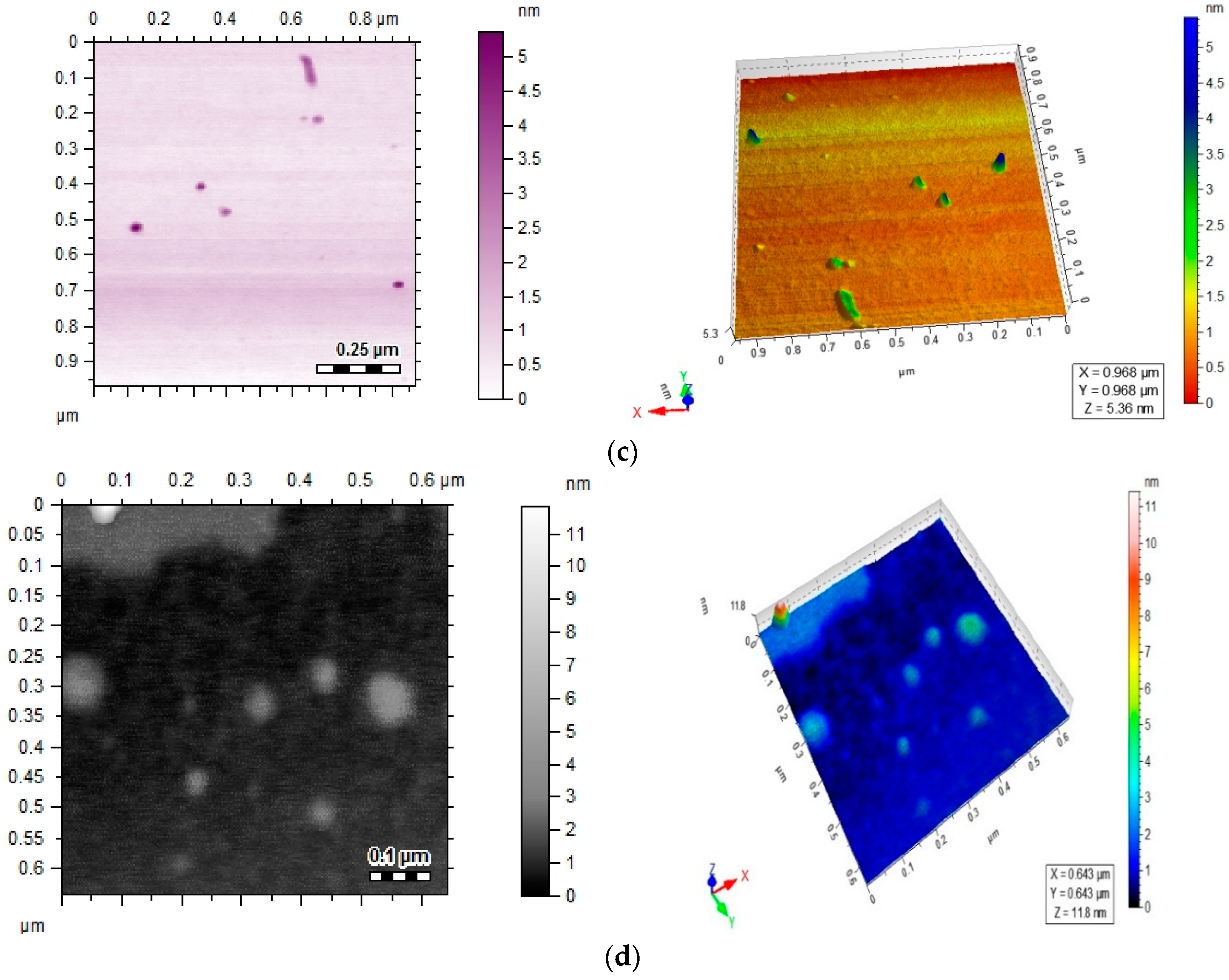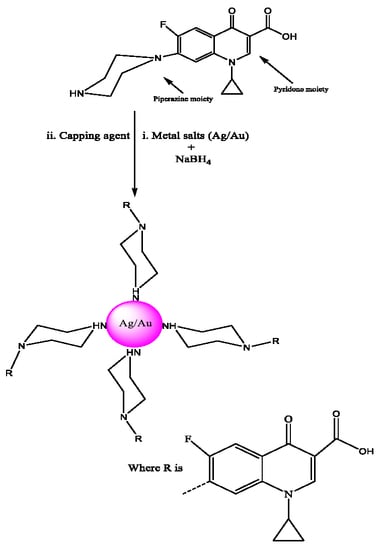Robust Synthesis of Ciprofloxacin-Capped Metallic Nanoparticles and Their Urease Inhibitory Assay
Abstract
:1. Introduction
2. Results and Discussions
2.1. UV-Visible Spectroscopy and Optical Inspection of Ag/Au-cip NPs
2.2. FTIR and AFM Studies
2.3. EDX and SEM Studies
2.4. Urease Inhibitory Assay
2.5. Antibacterial Activity
3. Experimental Section
3.1. Materials and Chemicals
3.2. Synthesis of Gold and Silver Nanoparticles
3.3. Factors Affecting the Stability of Silver and Gold Nanoparticles
3.3.1. Salt Effect
3.3.2. pH Effect
3.3.3. Temperature Effect
3.4. Characterization Techniques
3.4.1. UV-Visible Spectroscopy
3.4.2. Fourier Transform Infrared Spectroscopy (FTIR)
3.4.3. Atomic Force Microscopy (AFM)
3.4.4. Scanning Electron Microscopy (SEM) and Energy Dispersive X-ray (EDX) Analysis
3.5. Urease Inhibitory Assay
3.6. Antibacterial Activity
4. Conclusions
Acknowledgments
Author Contributions
Conflicts of Interest
References
- El-Ansary, A.; Al-Daihan, S. On the toxicity of therapeutically used nanoparticles: An overview. J. Toxicol. 2009, 2009. [Google Scholar] [CrossRef] [PubMed]
- Shameli, K.; Bin Ahmad, M.; Jaffar Al-Mulla, E.A.; Ibrahim, N.A.; Shabanzadeh, P.; Rustaiyan, A.; Zidan, M. Green biosynthesis of silver nanoparticles using Callicarpa maingayi stem bark extraction. Molecules 2012, 17, 8506–8517. [Google Scholar] [CrossRef] [PubMed]
- Connor, E.E.; Mwamuka, J.; Gole, A.; Murphy, C.J.; Wyatt, M.D. Gold nanoparticles are taken up by human cells but do not cause acute cytotoxicity. Small 2005, 1, 325–327. [Google Scholar] [CrossRef] [PubMed]
- Govindarajan, M.; Rajeswary, M.; Veerakumar, K.; Muthukumaran, U.; Hoti, S.L.; Benelli, G. Green synthesis and characterization of silver nanoparticles fabricated using Anisomeles indica: Mosquitocidal potential against malaria, dengue and Japanese encephalitis vectors. Exp. Parasitol. 2016, 161, 40–47. [Google Scholar] [CrossRef] [PubMed]
- Ghosh, P.; Han, G.; De, M.; Kim, C.K.; Rotello, V.M. Gold nanoparticles in delivery applications. Adv. Drug Deliv. Rev. 2008, 60, 1307–1315. [Google Scholar] [CrossRef] [PubMed]
- Pissuwan, D.; Niidome, T.; Cortie, M.B. The forthcoming applications of gold nanoparticles in drug and gene delivery systems. J. Control Release 2009, 149, 65–71. [Google Scholar] [CrossRef] [PubMed]
- Delehanty, J.B.; Boeneman, K.; Bradburne, C.E.; Robertson, K.; Bongard, J.E.; Medintz, I.L. Peptides for specific intracellular delivery and targeting of nanoparticles: Implications for developing nanoparticle-mediated drug delivery. Ther. Deliv. 2010, 1, 411–433. [Google Scholar] [CrossRef] [PubMed]
- Giljohann, D.A.; Seferos, D.S.; Daniel, W.L.; Massich, M.D.; Patel, P.C.; Mirkin, C.A. Gold nanoparticles for biology and medicine. Angew. Chem. Int. Ed. 2010, 49, 3280–3294. [Google Scholar] [CrossRef] [PubMed]
- Petros, R.A.; DeSimone, J.M. Strategies in the design of nanoparticles for therapeutic applications. Nat. Rev. Drug Discov. 2010, 9, 615–627. [Google Scholar] [CrossRef] [PubMed]
- Shi, J.; Votruba, A.R.; Farokhzad, O.C.; Langer, R. Nanotechnology in drug delivery and tissue engineering: From discovery to applications. Nano Lett. 2010, 10, 3223–3230. [Google Scholar] [CrossRef] [PubMed]
- Hayat, M. Colloidal Gold. In Principles, Methods and Applications; Academic Press: San Diego, CA, USA; London, UK, 1989. [Google Scholar]
- Khan, J.A.; Kudgus, R.A.; Szabolcs, A.; Dutta, S.; Wang, E.; Cao, S.; Curran, G.L.; Shah, V.; Curley, S.; Mukhopadhyay, D.; et al. Designing nanoconjugates to effectively target pancreatic cancer cells in vitro and in vivo. PLoS ONE 2011, 6, e20347. [Google Scholar] [CrossRef] [PubMed]
- Rao, C.R.; Kulkarni, G.U.; Thomas, P.J.; Edwards, P.P. Metal nanoparticles and their assemblies. Chem. Soc. Rev. 2000, 29, 27–35. [Google Scholar] [CrossRef]
- Pissuwan, D.; Valenzuela, S.M.; Miller, C.M.; Cortie, M.B. A golden bullet? Selective targeting of Toxoplasma gondii tachyzoites using antibody-functionalized gold nanorods. Nano Lett. 2007, 7, 3808–3812. [Google Scholar] [CrossRef] [PubMed]
- Huang, W.C.P.; Tsai, J.; Chen, Y.C. Functional gold nanoparticles as photothermal agents for selective-killing of pathogenic bacteria. Nanomedcine 2007, 2, 777–787. [Google Scholar] [CrossRef] [PubMed]
- Zharov, V.P.; Mercer, K.E.; Galitovskaya, E.N.; Smeltzer, M.S. Photothermal nanotherapeutics and nanodiagnostics for selective killing of bacteria targeted with gold nanoparticles. Biophys. J. 2006, 90, 619–627. [Google Scholar] [CrossRef] [PubMed]
- Cotton, F.A.; Wilkinson, G.; Murillo, C.A.; Bochmann, M.; Grimes, R. Advanced Inorganic Chemistry; Wiley: New York, NY, USA, 1999; p. 5. [Google Scholar]
- Cuff, M.E.; Miller, K.I.; van Holde, K.E.; Hendrickson, W.A. Crystal structure of a functional unit from octopus hemocyanin. J. Mol. Boil. 1998, 278, 855–870. [Google Scholar] [CrossRef] [PubMed]
- Solomon, E.I.; Sundaram, U.M.; Machonkin, T.E. Multicopper oxidases and oxygenases. Chem. Rev. 1996, 96, 2563–2606. [Google Scholar] [CrossRef] [PubMed]
- Kitajima, N.; Moro-oka, Y. Copper-dioxygen complexes. Inorganic and bioinorganic perspectives. Chem. Rev. 1994, 94, 737–757. [Google Scholar] [CrossRef]
- Magnus, K.A.; Ton-That, H.; Carpenter, J.E. Recent structural work on the oxygen transport protein hemocyanin. Chem. Rev. 1994, 94, 727–735. [Google Scholar] [CrossRef]
- Kitajima, N. Synthetic approach to the structure and function of copper proteins. Adv. Inorg. Chem. 1992, 39, 1–77. [Google Scholar]
- Holm, R.H.; Kennepohl, P.; Solomon, E.I. Structural and functional aspects of metal sites in biology. Chem. Rev. 1996, 96, 2239–2314. [Google Scholar] [CrossRef] [PubMed]
- Liang, H.C.; Dahan, M.; Karlin, K.D. Dioxygen-activating bio-inorganic model complexes. Curr. Opin. Chem. Biol. 1999, 3, 168–175. [Google Scholar] [CrossRef]
- Fox, S.; Karlin, K.D.; Valentine, J.S.; Foote, C.S.; Greenberg, A.; Liebman, J.F. Active Oxygen in Biochemistry; Valentine, J.S., Foote, C.S., Greenberg, A., Liebman, J.F., Eds.; Blackie Academic & Professional, Chapman & Hall: Glasgow, UK, 1995; pp. 188–231. [Google Scholar]
- Karlin, K.D.; Wei, N.; Jung, B.; Kaderli, S.; Niklaus, P.; Zuberbuehler, A.D. Kinetics and thermodynamics of formation of copper-dioxygen adducts: Oxygenation of mononuclear copper(I) complexes containing tripodal tetradentate ligands. J. Amer. Chem. Soc. 1993, 115, 9506–9514. [Google Scholar] [CrossRef]
- Karlin, K.D.; Tyeklar, Z. Bioinorganic Chemistry of Copper; Chapman & Hall: New York, NY, USA, 1993. [Google Scholar]
- Karlin, K.D. Metalloenzymes, structural motifs, and inorganic models. Science 1993, 261, 701–708. [Google Scholar] [CrossRef] [PubMed]
- Nisar, M.; Khan, S.A.; Shah, M.R.; Khan, A.; Farooq, U.; Uddin, G.; Ahmad, B. Moxifloxacin-capped noble metal nanoparticles as potential urease inhibitors. New J. Chem. 2015, 39, 8080–8086. [Google Scholar] [CrossRef]
- Schindler, S. Reactivity of copper(I) complexes towards dioxygen. Eur. J. Inorg. Chem. 2000, 2000, 2311–2326. [Google Scholar] [CrossRef]
- Wilcox, D.E. Binuclear metallohydrolases. Chem. Rev. 1996, 96, 2435–2458. [Google Scholar] [CrossRef] [PubMed]
- Sumner, J.B. The isolation and crystallization of the enzyme urease. Preliminary paper. J. Biol. Chem. 1926, 69, 435–441. [Google Scholar]
- Mobley, H.L.; Island, M.D.; Hausinger, R.P. Molecular biology of microbial ureases. Microbiol. Rev. 1995, 59, 451–480. [Google Scholar] [PubMed]
- Arfan, M.; Ali, M.; Ahmad, H.; Anis, I.; Khan, A.; Choudhary, M.I.; Shah, M.R. Urease inhibitors from Hypericum oblongifolium WALL. J. Enz. Inhibit. Med. Chem. 2010, 25, 296–299. [Google Scholar] [CrossRef] [PubMed]
- Bremner, J.M. Recent research on problems in the use of urea as a nitrogen fertilizer. Nitrogen Econ. Trop. Soils 1996, 69, 321–329. [Google Scholar]
- Mulvaney, R.L.; Bremner, J.M. Use of Urease and Nitrification Inhibitors for Control of Urea Transformations in Soils; Marcel Dekker: New York, NY, USA, 1981; pp. 153–196. [Google Scholar]
- Khan, I.; Ali, S.; Hameed, S.; Rama, N.H.; Hussain, M.T.; Wadood, A.; Uddin, R.; Ul-Haq, Z.; Khan, A.; Ali, S.; et al. Synthesis, antioxidant activities and urease inhibition of some new 1,2,4-triazole and 1,3,4-thiadizole derivatives. Eur. J. Med. Chem. 2010, 45, 5200–5207. [Google Scholar] [CrossRef] [PubMed]
- Amtul, Z.; Rasheed, M.; Choudhary, M.I.; Rosanna, S.; Khan, K.M. Kinetics of novel competitive inhibitors of urease enzymes by a focused library of oxadiazoles/thiadiazoles and triazoles. Biochem. Biophys. Res. Commun. 2004, 319, 1053–1063. [Google Scholar] [CrossRef] [PubMed]
- Mitscher, L.A. Bacterial topoisomerase inhibitors: Quinolone and pyridone antibacterial agents. Chem. Rev. 2005, 105, 559–592. [Google Scholar] [CrossRef] [PubMed]
- Andriole, V.T. The Quinolones; Academic Press: New York, NY, USA, 2000. [Google Scholar]
- Hooper, D.C.; Rubinstein, E. Quinolone. In Antimicrobial Agents, 3rd ed.; ASM Press: Washington, DC, USA, 2003. [Google Scholar]
- Turel, I. The interactions of metal ions with quinolone antibacterial agents. Coord. Chem. Rev. 2002, 232, 27–47. [Google Scholar] [CrossRef]
- King, D.E.; Malone, R.; Lilley, S.H. New classification and update on the quinolone antibiotics. Am. Family Phys. 2000, 61, 2741–2748. [Google Scholar]
- Stein, G.E. Pharmacokinetics and pharmacodynamics of newer fluoroquinolones. Clin. Infect. Dis. 1996, 23, S19–S24. [Google Scholar] [CrossRef] [PubMed]
- Stein, G.E.; Havlichek, D.H. Newer oral antimicrobials for resistant respiratory tract pathogens. Which show the most promise? Postgrad. Med. 1998, 103, 67–70. [Google Scholar] [CrossRef] [PubMed]
- Uivarosi, V. Metal complexes of quinolone antibiotics and their application: An update. Molecules 2013, 18, 11153–11197. [Google Scholar] [CrossRef] [PubMed]
- Ghosh, S.; Anand, U.; Mukherjee, S. Investigating the evolution of drug mediated silver nanoparticles. Analyst 2013, 138, 4270–4274. [Google Scholar] [CrossRef] [PubMed]
- Turkevich, J.; Stevenson, P.C.; Hillier, J. The size and shape factor in colloidal systems. Gen. Discuss. Faraday Soc. 1951, 11, P001–P008. [Google Scholar]
- Oh, E.; Susumu, K.; Goswami, R.; Mattoussi, H. One-phase synthesis of water-soluble gold nanoparticles with control over size and surface functionalities. Langmuir 2010, 26, 7604–7613. [Google Scholar] [CrossRef] [PubMed]
- Sample Availability: Samples of the various experiments are available from the authors.






| Sample | Ag | Ciprofloxacin | Ag-Cip NPs | Au-Cip NPs | STD |
|---|---|---|---|---|---|
| % Inhibition | 29.2 | 75 | 96 | 90 | 98.2 |
| Concentration (mg/mL) | 0.2 | 0.2 | 0.2 | 0.2 | 0.5 (mM) |
| IC50 ± S.E.M (μg/mL) | NA | 82.95 ± 1.62 | 1.181 ± 0.02 | 52.55 ± 2.3 | 21 ± 0.11 (µM) |
| Bacterial Strain | Strain | Ciprofloxacin | Ag-Cip NPs | Au-Cip NPs | Streptomycin (STD) |
|---|---|---|---|---|---|
| S. aureus | + | 26 | 24 | 22 | 26 |
| Bacillus subtilis | + | 28 | 22 | 24 | 26 |
| K. pneumoniae | - | 24 | 20 | 24 | 28 |
© 2016 by the authors. Licensee MDPI, Basel, Switzerland. This article is an open access article distributed under the terms and conditions of the Creative Commons by Attribution (CC-BY) license ( http://creativecommons.org/licenses/by/4.0/).
Share and Cite
Nisar, M.; Khan, S.A.; Qayum, M.; Khan, A.; Farooq, U.; Jaafar, H.Z.E.; Zia-Ul-Haq, M.; Ali, R. Robust Synthesis of Ciprofloxacin-Capped Metallic Nanoparticles and Their Urease Inhibitory Assay. Molecules 2016, 21, 411. https://doi.org/10.3390/molecules21040411
Nisar M, Khan SA, Qayum M, Khan A, Farooq U, Jaafar HZE, Zia-Ul-Haq M, Ali R. Robust Synthesis of Ciprofloxacin-Capped Metallic Nanoparticles and Their Urease Inhibitory Assay. Molecules. 2016; 21(4):411. https://doi.org/10.3390/molecules21040411
Chicago/Turabian StyleNisar, Muhammad, Shujaat Ali Khan, Mughal Qayum, Ajmal Khan, Umar Farooq, Hawa Z.E. Jaafar, Muhammad Zia-Ul-Haq, and Rashid Ali. 2016. "Robust Synthesis of Ciprofloxacin-Capped Metallic Nanoparticles and Their Urease Inhibitory Assay" Molecules 21, no. 4: 411. https://doi.org/10.3390/molecules21040411
APA StyleNisar, M., Khan, S. A., Qayum, M., Khan, A., Farooq, U., Jaafar, H. Z. E., Zia-Ul-Haq, M., & Ali, R. (2016). Robust Synthesis of Ciprofloxacin-Capped Metallic Nanoparticles and Their Urease Inhibitory Assay. Molecules, 21(4), 411. https://doi.org/10.3390/molecules21040411








